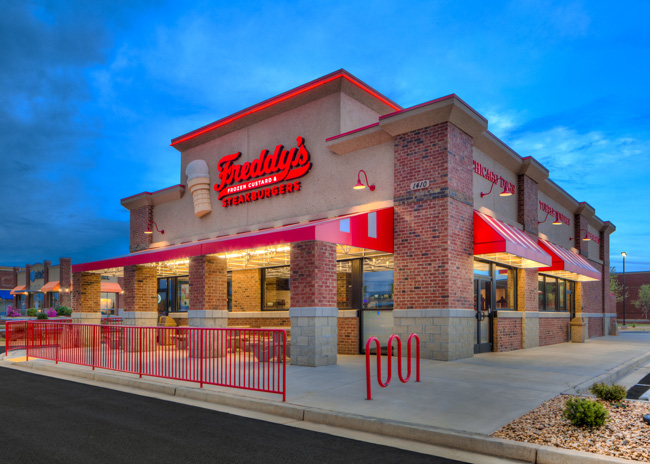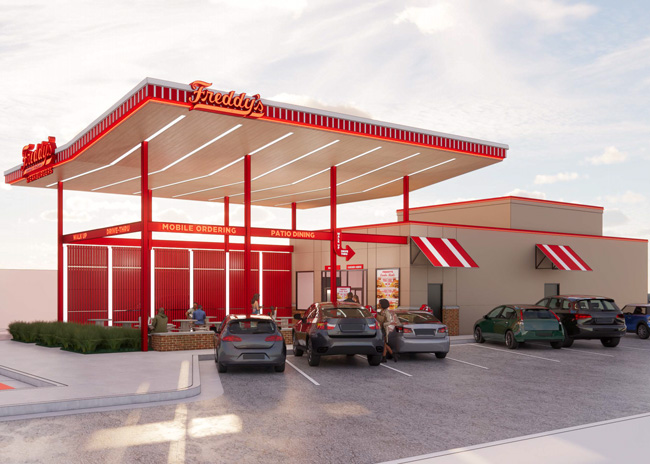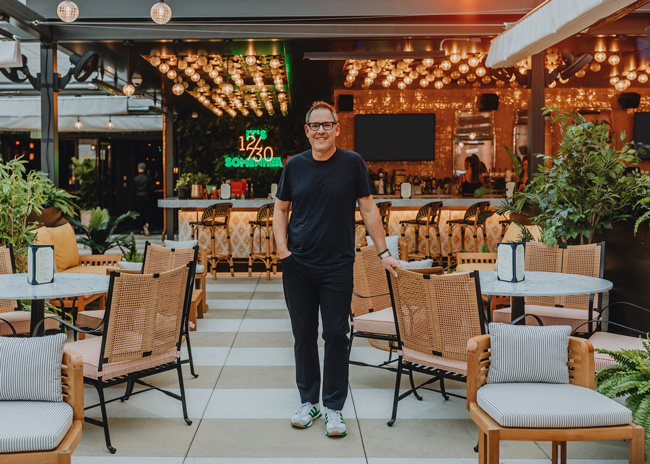Next month Freddy’s Frozen Custard & Steakburgers will open the first store featuring its new prototype design, in Salinas, Kansas.
The goal with the new design, says Chris Dull, president and CEO of the Wichita, Kansas-based brand, was to have more real estate options, to be able to satisfy on-the-go guests and to serve mobile customers curbside or at a window.
The new locations will have no dining room, but instead some patio seats and a streamlined kitchen, designed to service both a double drive-thru, a walkup ordering station and curbside pickup.
Designing a prototype is no mean feat. Here we look at five best practices for creating one:
1. Be inclusive.
Involve as many people as you can in the process of designing your prototype, from operations staff, who have valuable information, to marketing people, design professionals, back-of-house and front-of-house employees, says Dawn Arcieri, NCIDQ, RID, IIDA, managing principal, interiors, at Element Architects in Houston. “All the stakeholders need to be involved in that decision making.”
2. Be flexible.
Freddy’s traditional stores require a full acre or more but with their new prototype, the brand can move into three-quarters of an acre or slightly smaller.
Freddy’s started with one version of its prototype but once that’s been open for a few months, Dull plans to take key lessons “to help us make changes or modifications or to potentially develop some additional prototypes spun off this original.”
Incorporate flexibility in both the real estate and footprint. But be sure to offer a variety of adaptations for franchisees to choose from, depending on the financial investments they’re able, or willing, to make, Arcieri points out.
Restaurants need to be forward-thinking, Arcieri notes, especially if they work with franchisees, who will not want to redesign or update constantly. “You have to stay on that cutting edge but have some longevity at the same time. You have to anticipate the trends for the next 5 to 10 years.”

3. Put guests first.
Freddy’s has incorporated a door from the kitchen leading to the drive-thru in its new prototype, so employees can step out and help guests with faster orders to satisfy the need for speed.
New prototypes should be designed with the concept’s guest in mind. “The first part is really understanding the consumer’s ask,” says Dull, who began the process of prototype design with research and studying his customers’ behavior and understanding his drive-thrus. “Anything that doesn’t start with consumer insights is flawed. We understand they’re looking for fast, convenient and mobile-friendly.”
This process meant hiring an outside firm, which ran focus groups and customer intercepts to find out what people wanted from Freddy’s. The company also examined industry best practices and the competitive profile.
“We looked at trend data around fast casual and QSRs in general, so it was a pretty robust capture of all things happening in our industry related to speed of service, guests on the go, mobile-mindedness and best practices,” Dull says. “It was quite an endeavor, but having consumer feedback and strong data from your end-user is imperative.” Freddy’s also solicited input from its franchisee advisory council.
Know your customer, understand the market “and understand your market,” says Arcieri. “And understand your competitor — who are you up against? What sets you apart?” She recommends hiring an outside firm to do this research for you, and preferably one that works specifically with your type of restaurant.

4. Stay true to your brand.
Whatever you decide to focus on with your prototype, it must stay true to your brand commitment.
“The brand encompasses who you are and where you are in the market and you need to understand the brand,” says Arcieri. “Remember you’re not designing for yourself but for your brand. We keep that brand statement, that brand essence, in front of us at all times.”
Freddy’s takes great pride in genuine hospitality “and making sure our guests are treated well and recognized and appreciated,” Dull says. “In a speedier environment it can be challenging to make sure you meet that brand promise, and you have to make sure your messaging is consistent.”
5. Visualize and refine.
When Golden Corral created a new prototype in 2016, the chain rented a warehouse and created a full mockup of the new restaurant using plywood and cardboard.
It’s a terrific idea, but is probably too expensive for most restaurant operators, says Arcieri, but having a mockup of your new prototype is invaluable. She suggests using building information modeling software that can support 3D modeling. “With technology these days it’s pretty easy to see the space before you even put the first nail in the ground,” says Arcieri.



